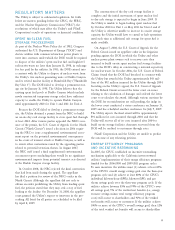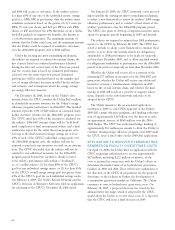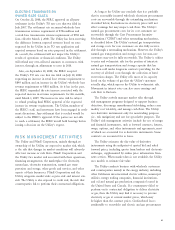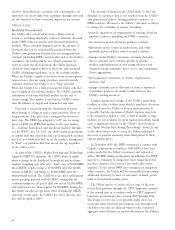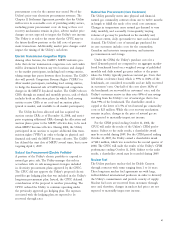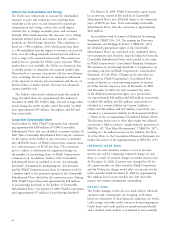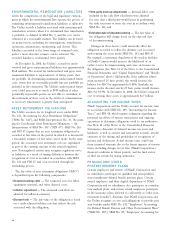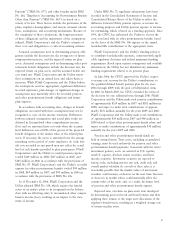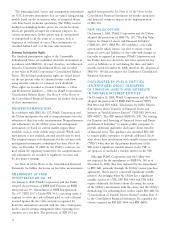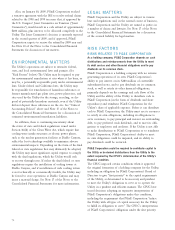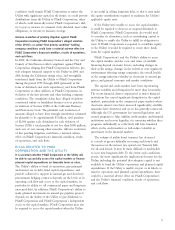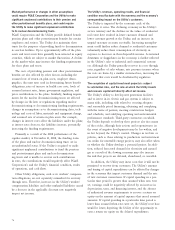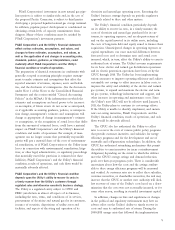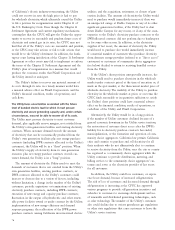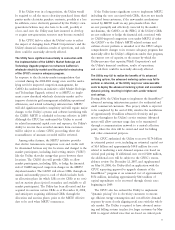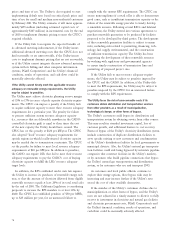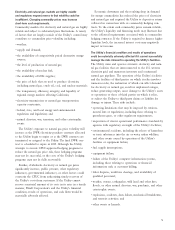PG&E 2008 Annual Report Download - page 71
Download and view the complete annual report
Please find page 71 of the 2008 PG&E annual report below. You can navigate through the pages in the report by either clicking on the pages listed below, or by using the keyword search tool below to find specific information within the annual report.
69
Price Risk Management Instruments
The price risk management instrument category comprises
physical and fi nancial derivative contracts including futures,
forwards, options, and swaps that are both exchange-traded
and over-the-counter (“OTC”) traded contracts. PG&E
Corporation and the Utility apply consistent valuation meth-
odology to similar instruments. Since the Utility’s contracts
are used within the regulatory framework, regulatory accounts
are recorded to offset the associated gains and losses of these
derivatives, which will be refl ected in future rates. The Level 3
price risk management instruments decreased from an asset
of approximately $115 million as of January 1, 2008 to a
liability of approximately $156 million as of December 31,
2008. This decrease of approximately $271 million was
primarily due to a reduction in commodity prices.
Value as of
December 31, January 1,
(in millions) 2008 2008
Type of Instrument
Options (exchange-traded and OTC) $ 28 $
50
Congestion revenue rights,
Firm transmission rights, and
Demand response contracts 99 61
Swaps and forwards (366) (2)
Netting and collateral 83 6
Total $(156) $115
All options (exchange-traded and OTC) are valued using
the Black’s Option Pricing Model and classifi ed as Level 3
measurements primarily due to volatility inputs. The Utility
receives implied volatility for options traded on exchanges
that may be adjusted to incorporate the specifi c terms of the
Utility’s contracts, such as strike price or location.
CRRs allow market participants, including load serving
entities, to hedge fi nancial risk of CAISO-imposed conges-
tion charges in the day-ahead market to be established when
MRTU becomes effective. FTRs allow market participants,
including load serving entities, to hedge both the physical
and fi nancial risk associated with CAISO-imposed conges-
tion charges until the MRTU becomes effective. The Utility’s
demand response contracts with third-party aggregators of
retail electricity customers contain a call option entitling the
Utility to require that the aggregator reduce electric usage by
the aggregators’ customers at times of peak energy demand
or in response to a CAISO alert or other emergency. As the
markets for CRRs, FTRs, and demand response contracts
have minimal activity, observable inputs may not be available
in pricing these instruments. Therefore, the pricing models
used to value these instruments often incorporate signifi cant
estimates and assumptions that market participants would
use in pricing the instrument. Accordingly, they are classifi ed
as Level 3 measurements. When available, observable market
data is used to calibrate pricing models.
Money Market Investments
PG&E Corporation invests in AAA-rated money market
funds that seek to maintain a stable net asset value. These
funds invest in high quality, short-term, diversifi ed money
market instruments, such as Treasury bills, federal agency
securities, certifi cates of deposit, and commercial paper with
a maximum weighted average maturity of 60 days or less.
PG&E Corporation’s investments in these money market
funds are generally valued based on observable inputs such
as expected yield and credit quality and are thus classifi ed
as Level 1 instruments. Approximately $164 million held in
money market funds are recorded as Cash and cash equiva-
lents in PG&E Corporation’s Consolidated Balance Sheets.
As of December 31, 2008, PG&E Corporation classifi ed
approximately $12 million invested in one money market
fund as a Level 3 instrument because the fund manager
imposed restrictions on fund participants’ redemption
requests. PG&E Corporation’s investment in this money
market fund, previously recorded as Cash and cash equiva-
lents, is recorded as Prepaid expenses and other in PG&E
Corporation’s Consolidated Balance Sheets.
Nuclear Decommissioning Trusts
and Long-Term Disability Trust
The nuclear decommissioning trusts and the long-term
disability trust primarily hold equities, debt securities,
mutual funds, and life insurance policies. These instruments
are generally valued based on unadjusted prices in active
markets for identical transactions or unadjusted prices in
active markets for similar transactions. The nuclear decom-
missioning trusts and the long-term disability trust also
invest in long-term commingled funds, which are funds that
consist of assets from several accounts that are intermingled.
These commingled funds have liquidity restrictions and lack
an active market for individual shares of the funds; there-
fore, the trusts’ investments in these funds are classifi ed as
Level 3. The Level 3 nuclear decommissioning trust assets
decreased from approximately $8 million at January 1, 2008
to approximately $5 million at December 31, 2008. The
decrease of approximately $3 million for the twelve months
ended December 31, 2008 was primarily due to unrealized
losses of these commingled fund investments. The Level 3
long-term disability trust assets decreased from approximately
$87 million at January 1, 2008 to approximately $78 mil-
lion at December 31, 2008. This decrease of approximately
$9 million for the twelve months ended December 31, 2008
was primarily due to net purchases and unrealized losses
on these commingled fund investments.


